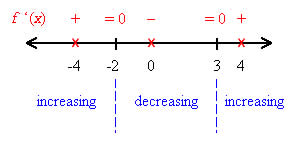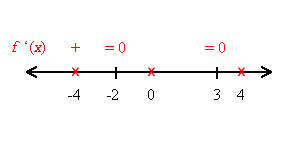
Problem 1 Find all relative extrema of
$latex \displaystyle f(x)=2{{x}^{3}}-3{{x}^{2}}-36x$
Solution To find the relative extrema, we must track whether the derivative is zero, positive or negative.
First, let’s find the critical points. Critical point are where the derivative is equal to zero or undefined. The derivative is
$latex \displaystyle {f}'(x)=6{{x}^{2}}-6x-36$
Set the derivative equal to zero. The resulting equation may be solved by factoring.
$latex \displaystyle 6{{x}^{2}}-6x-36=0$
The least common multiple may be factored from the left side,
$latex \displaystyle 6({{x}^{2}}-x-6)=0$
Now factor the trinomial,
$latex \displaystyle 6(x-3)(x+2)=0$
Set each of the factors containing variables equal to zero to give
$latex \displaystyle x=3\quad x=-2$
Place these critical numbers along with points on either side of them on a number line.
The critical numbers are labeled with black tic marks on the number line and also = 0 to indicate that they were found by setting the derivative equal to zero. The testing points at -4, 0, and 4 are labeled with an x on the number line. To do the testing, it is useful to have the factored form of the derivative,
$latex \displaystyle {f}'(x)=6(x-3)(x+2)$
Let’s test the derivative at -4. We don’t need the exact value of the derivative…only whether its sign is positive or negative.
$latex \displaystyle {f}'(4)=6(-4-3)(-4+2)$
The factors are +, -, and -. The product is (+)(-)(-) or +. Label a + above -4 to indicate that the derivative is positive.
Continue testing at 0 and 4 to fill out the number line below.

$latex \displaystyle f(-2)=2{{(-2)}^{3}}-3{{(-2)}^{2}}-36(-2)=44$
or (-2, 44).
At x = 3, the function changes from decreasing to increasing so it is a relative minimum. The value of the minimum is
$latex \displaystyle f(-2)=2{{(3)}^{3}}-3{{(3)}^{2}}-36(3)=-81$
or (3, -81).
Absolute extrema are the very highest and lowest points on a graph. If a graph is continuous, we can find the absolute extrema on a closed interval by finding the function values at the critical points and the endpoints.
Problem 2 Find all absolute extrema of
$latex \displaystyle f(x)=2{{x}^{3}}-3{{x}^{2}}-36x$
on the interval [-5, 5].
Solution The highest and lowest points will be at the endpoints or critical points. The derivative is
$latex \displaystyle {f}'(x)=6{{x}^{2}}-6x-36$
Set the derivative equal to zero. The resulting equation may be solved by factoring.
$latex \displaystyle 6{{x}^{2}}-6x-36=0$
The least common multiple may be factored from the left side,
$latex \displaystyle 6({{x}^{2}}-x-6)=0$
Now factor the trinomial,
$latex \displaystyle 6(x-3)(x+2)=0$
Set each of the factors containing variables equal to zero to give
$latex \displaystyle x=3\quad x=-2$
The highest and lowest points can be distinguished using the original function.
| x | f(x) | |
|---|---|---|
| -5 | -145 | absolute minimum |
| -2 | 44 | absolute maximum |
| 3 | -81 | |
| 5 | -5 |
The graph below for f (x) confirms the absolute max and min as well as the relative max and min.



